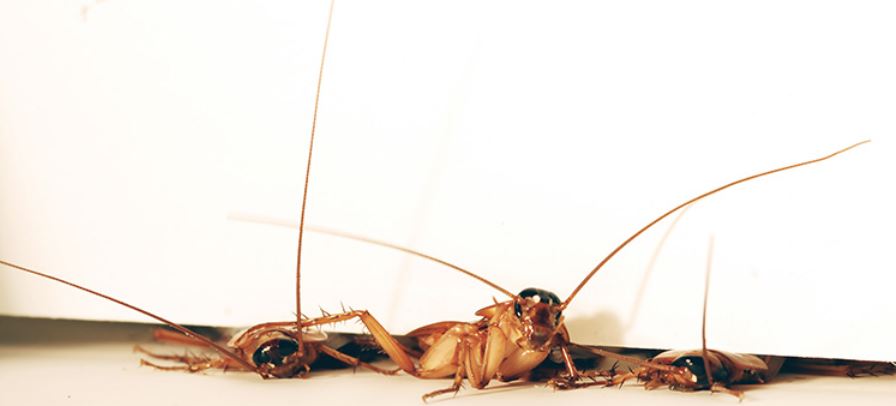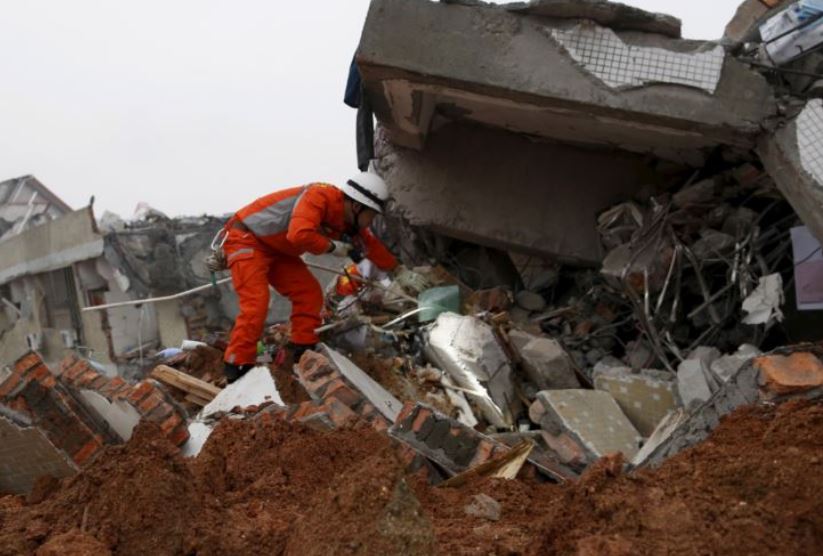A robot cockroach that squeezes through tiny cracks, just like the real thing, would be great for rescue missions following natural disasters, such as earthquakes and tornadoes, as well as explosions, says a team of scientists. It would be able to get right into the debris rapidly and tell rescuers whether there were any trapped survivors.
People’s fear and disgust of cockroaches, insects that are not only able to squeeze through tiny cracks, but can run amazingly fast when flattened in half and can penetrate the tiniest joints and seams in less than a second, has inspired the creation of a robot that does the same.
For those with Katsaridaphobia (fear of cockroaches), next time you see one, tell yourself “You inspired a bunch of scientists to create a robot that will save many lives”. You never know, it might help get rid of or reduce the severity of the phobia.
 The CRAM robot, inspired by cockroaches, can crawl through gaps even when squashed to half its size. (Image: news.berkeley.edu. Credit: Tom Libby, Kaushik Jayaram and Pauline Jennings. Courtesy of PolyPEDAL Lab UC Berkeley)
The CRAM robot, inspired by cockroaches, can crawl through gaps even when squashed to half its size. (Image: news.berkeley.edu. Credit: Tom Libby, Kaushik Jayaram and Pauline Jennings. Courtesy of PolyPEDAL Lab UC Berkeley)
They can run ultra-fast even when squashed
Study leader Kaushik Jayaram, who recently completed his doctorate at the University of California, Berkeley (UC Berkeley), and is today a postdoctoral fellow at Harvard University, said:
“What’s impressive about these cockroaches is that they can run as fast through a quarter-inch gap as a half-inch gap, by reorienting their legs completely out to the side.”
What is a robot?
Dr. Jayaram and colleagues wrote about the robot they created in the peer-reviewed academic journal Proceedings of the National Academy of Sciences (PNAS).
“They’re about half an inch tall when they run freely, but can squish their bodies to one-tenth of an inch – the height of two stacked pennies.”
Cockroaches can withstand amazing force
Dr. Jayaram found that cockroaches traversing crevices are able to withstand forces nine hundred times their body weight without injury.
Dr. Jayaram designed a simple and cheap palm-sized robot that can splay its legs outwards when squeezed or squashed, then covered it with a plastic shield similar to the smooth, tough wings covering the back of the real insect. He said he used the cockroach technique as inspiration.
The little robot is called CRAM, which stands for Compressible Robot with Articulated Mechanisms. It can squeeze into crevices half its height, and still run fast when squashed!
 The American cockroach is able to squeeze through a tiny crack the width of two stacked pennies. If we tried to do the same we’d have to be pushed through and would come out of the other side with a crushed skull, massive haemorrhaging, most of our skin torn off, and lots of broken bones – we’d definitely be dead. (Image: news.berkeley.edu. Credit: Tom Libby, Kaushik Jayaram and Pauline Jennings. Courtesy of PolyPEDAL Lab UC Berkeley)
The American cockroach is able to squeeze through a tiny crack the width of two stacked pennies. If we tried to do the same we’d have to be pushed through and would come out of the other side with a crushed skull, massive haemorrhaging, most of our skin torn off, and lots of broken bones – we’d definitely be dead. (Image: news.berkeley.edu. Credit: Tom Libby, Kaushik Jayaram and Pauline Jennings. Courtesy of PolyPEDAL Lab UC Berkeley)
Co-author, Robert Full, a professor of integrative biology (focuses on the integration of structure and function that influences the biology, ecology, and evolution of organisms) at UC Berkeley, said:
“In the event of an earthquake, first responders need to know if an area of rubble is stable and safe, but the challenge is, most robots can’t get into rubble.”
“But if there are lots of cracks and vents and conduits, you can imagine just throwing a swarm of these robots in to locate survivors and safe entry points for first responders.”
Dr. Jayaram created the model robot utilizing an origami-like manufacturing technique, which today is available as a cheap kit made by Dash Robotics – a spin-off firm from previous UC Berkeley robotic work.
Insects great for robot locomotion study
The research team said they now need several more robust versions for real-world testing.
Prof. Full said:
“This is only a prototype, but it shows the feasibility of a new direction using what we think are the most effective models for soft robots, that is, animals with exoskeletons.”
“Insects are the most successful animals on earth. Because they intrude nearly everywhere, we should look to them for inspiration as to how to make a robot that can do the same.”
 A robot that can do this would be excellent in rescue efforts when attempting to find survivors trapped under the debris following an earthquake, tornado or explosion. (Image: ciber.berkeley.edu)
A robot that can do this would be excellent in rescue efforts when attempting to find survivors trapped under the debris following an earthquake, tornado or explosion. (Image: ciber.berkeley.edu)
Animal locomotion
Over the past thirty years, Prof. Full and students at his Poly-PEDAL laboratory have been studying how animals walk, crawl, run, jump, slither and glide to get a good understanding of the basic biomechanical principles that underlie locomotion – the aim being to design better and more effective robots.
Their studies and findings have inspired robots with legs like crabs and cockroaches, as well as adhesive feet like those of geckos, which can climb up vertical smooth walls.
Twenty-five years ago, Prof. Full discovered that American cockroaches can run just on two legs – an accomplishment certified by the Guinness Book of World Records. The insect can also achieve a speed of almost 5 feet per second, which is fifty times its body length per second.
Dr. Jayaram placed dinner-plates a quarter-inch apart, and then filmed cockroaches running between them at almost full speed. He gradually narrowed the gaps between the plates and found that these amazing insects can slip through gaps just one-tenth of an inch across if highly motivated.
 A rescuer trying to determine whether survivors might be trapped under the debris. Imagine how much more effective his effort would be if he could send a couple of dozen robot cockroaches to slip through the cracks and gaps, get right into the debris and find people. (Image: gdb.voanews.com)
A rescuer trying to determine whether survivors might be trapped under the debris. Imagine how much more effective his effort would be if he could send a couple of dozen robot cockroaches to slip through the cracks and gaps, get right into the debris and find people. (Image: gdb.voanews.com)
Locomotion using sensory spines on tibia
When they’re squashed, they are unable to use their feet properly, so they use the sensory spines on their tibia to push against the floor and move forward.
Dr. Jayaram said:
“They have to use different body parts to move in these spaces, because their legs and feet are not oriented to work properly. But they are still capable of generating the large forces necessary for locomotion, which blew my mind.”
Dr. Jayaram stuck sandpaper to the top and bottom of crevices to see how friction might affect the cockroach’s ability to move. He found that a smooth top shell and not too much floor friction were crucial, since the insect needs to have sufficient friction to propel itself forward, but not so much that its speed is undermined.
The authors call this new mode of locomotion “body frictional legged crawling with drag on the body,” since thrust by legs is dominated by friction but there is no drag from flowing media, such as sand, water or air. Perhaps they will soon come up with a shorter term.
Dr. Jayaram is currently testing all the cockroach’s parts to determine their mechanical properties and how they contribute to the insect’s locomotion.
In an Abstract in the journal, the authors wrote:
“Exoskeletal strength allowed cockroaches to withstand forces 300 times body weight when traversing the smallest crevices and up to nearly 900 times body weight without injury. Cockroach exoskeletons provided biological inspiration for the manufacture of an origami-style, soft, legged robot that can locomote rapidly in both open and confined spaces.”
The study was funded by the Army Research Laboratory through the Micro Autonomous Systems and Technology (MAST), the US Army, and a Collaborative Technology Alliance involving industry.
Citation: “Cockroaches traverse crevices, crawl rapidly in confined spaces, and inspire a soft, legged robot,” Kaushik Jayarama and Robert J. Full. Proceedings of the National Academy of Sciences (PNAS). 8 February, 2016. DOI: 10.1073/pnas.1514591113.
Video – Cockroach robots to the rescue!
This Berkeley News video explains how researchers studied the cockroach’s Houdini-like contortions and applied them to a new robot that could be used in rescue missions following earthquakes and other disasters where buildings collapsed.
